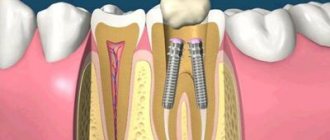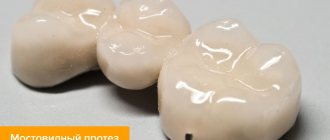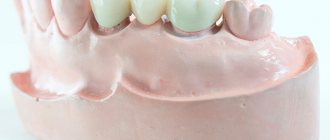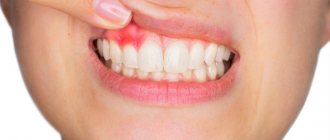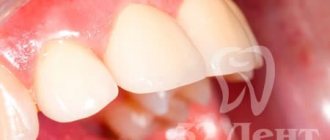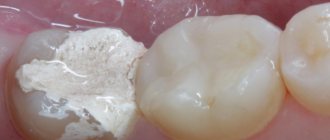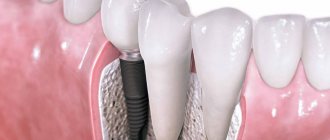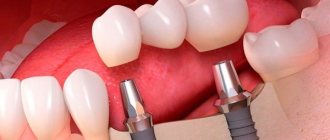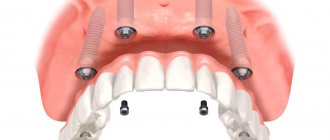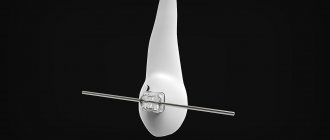Today, dozens of methods have been developed to restore and correct teeth, each of which is designed to quickly and painlessly solve a specific clinical problem. In cases of carious destruction, inlays have proven themselves to be the best, and if the tooth lacks support, pins come to the rescue.
The installation of a pin during dental prosthetics is carried out as follows: one end of the rod is screwed into the root canal, and a new beautiful tooth is attached to the other.
Pin in a tooth - what is it?
Phrases from the series “putting a tooth on a pin,” “building a tooth on a pin,” or “tooth under a pin” sound quite scary for many patients. However, in reality, restoring a tooth with a pin will help avoid its removal, and the design itself does not cause any discomfort. A dental pin is placed into the root canal. The device performs a supporting function and helps to optimally distribute the load on the tooth. Since a pin is placed in the root of the tooth, a number of therapeutic and endodontic procedures must be carried out before starting treatment.
Indications for installing a pin in a tooth
- Serious damage to the coronal part. A tooth without a post has a higher risk of destruction after treatment if more than 50% of its visible part is initially damaged.
- Repeated dental treatment due to secondary caries or destruction of tooth tissue due to other reasons.
- The need for additional supporting and fixing elements for installing a crown.
- When preparing the abutment tooth for fixing the prosthesis.
- For the treatment of advanced forms of periodontitis and periodontal disease. Pins are installed on loose teeth for subsequent splinting.
- During tooth replantation (in rare cases).
Contraindications to the procedure are related to the condition of the tooth (severe damage, too thin walls), anatomical features and pathologies of the root canal structure, as well as concomitant diseases (caries, acute periodontitis, cyst, granuloma, abscess, mental disorders) and body conditions (pregnancy) .
Dental pins - what are they?
Today, doctors have a wide selection of dental pins, varying in shape, material and area of application.
Dental pin materials
- Metal.
The most popular options: titanium, brass, palladium and precious alloys. - Metal-free.
They are made from gutta-percha, ceramics, fiberglass and carbon fiber.
Forms
- screw
- cylindrical
- conical
- combined
Recovery methods
- pins for tooth crown
- tooth filling on a pin
Mounting methods
- Active.
Threaded pins are screwed into the root canal, thereby achieving a tighter fixation. However, there is a risk of perforation of the canal walls. - Passive.
A more gentle (but less reliable) method of fastening. The pin is placed inside the root canal and fixed using a special compound.
Alternative strengthening options
An adequate alternative to parapulp rods can be restorative inlays (for extensive damage to the crown) or veneers (for minor damage to the front teeth). A filling, in principle, can also be considered as an option - but its service life is shorter, it will quickly sag or chip.
South Korean implant Osstem - 20,000 rub.
Hurry up to sign up for a free consultation and lock in promotional prices.
Call now or request a call
Opening hours: 24 hours a day - seven days a week
Stump inlays are an optimal replacement for in-canal structures, because... they are stronger and more durable, and distribute the chewing load much better.
Read on the topic: what are dental inlays and who are they suitable for? A complete list of designs and materials for their manufacture in one article.
Types of dental pins
Gutta-percha
Filling dental canals with gutta-percha pins allows you to achieve predictable results, since the entire root canal cavity is filled. However, the gutta-percha pin cannot perform a full support function.
Metal pins in teeth (anchors)
Most types of anchor pins are made of metal, threaded, and installed using the active method. An anchor pin in a tooth is a classic option that is most often used for fixing crowns (a crown on a tooth on a pin). There are also modern analogues: these pins have a smooth surface and are made of ceramic, but some experts no longer call these products anchors.
Fiberglass
Fiberglass teeth pins are sufficiently strong, elastic and safe. They are almost transparent, so they are actively used to restore teeth in the smile area. The front tooth on a fiberglass post looks quite aesthetically pleasing, since the material does not stain over time and is generally quite durable.
Carbon fiber
Another type of modern and popular pins, which are as similar as possible to the structure of dental tissues. They are very durable, help to optimally distribute the load and prevent root fractures.
Attention!
To restore teeth, pin inlays are also used - these are solid structures made of metal alloys or ceramics, the base of which is installed in the root canals, and the stump imitates part of the crown.
When installing a structure fails
It is not always possible for a specialist to install an anchor pin - there are a number of contraindications to its use. In addition to the fact that the clinical picture must meet the above requirements (2-3 mm of dental tissue above the gum level and at least 2 mm of root thickness), the patient should not have the following problems: chronic inflammatory processes in the soft tissues of the oral cavity, canal obstruction, neoplasms in the root area. Contraindications also include blood clotting disorders and disruptions in the functioning of the nervous system.
It is not possible to use with severely damaged teeth.
How is a pin inserted into a tooth?
Installing a pin into the root of a tooth is a rather labor-intensive process, including diagnosis and preliminary treatment of canals. Further actions depend on the treatment method. The first option is to place a pin and build up the tooth using composite materials. The second option, a tooth prosthesis on a pin, involves installing a crown. Dental prosthetics with a pin is not performed. The role of the prosthesis is performed by the crown, and the pin is only an additional supporting element. Finally, the extended tooth on the pin is polished and brought into proper condition. In the case of a crown, the doctor makes sure that the prosthetics was successful.
Titanium pin in tooth
The pins located in the tooth canals can be made of titanium, but they should not be confused with implants. Dental pins belong to endodontics and partly to orthopedics, while implantation is a separate area. When a titanium pin is placed in an extracted tooth, the product is called an “implant.” This is an artificial root that is implanted in place of a lost tooth. Theoretically, a dental implant can be called a titanium post (which many people often do), but compared to classic posts, it performs a completely different function. The advantages of implantation today are undeniable: if a natural tooth is lost, it is the implant that can best restore its functionality and aesthetics.
Care after installation
After the restoration, the specialist will definitely give detailed recommendations regarding care during rehabilitation and recovery. So, for about a week it is better to stop eating solid foods and using toothpicks.
In the future, care should be taken to treat the restored tooth, trying to protect it from excessive mechanical loads and traumatic factors. An important condition is responsible adherence to the rules of hygiene: regular brushing of teeth twice every day, rinsing the mouth after meals, systematic visits to the dentist for preventive examinations.
Proper dental hygiene is important to maintain your smile.
What to do if a tooth with a pin hurts?
Painful sensations may well occur after installation of the pin, since surrounding tissues were affected during the treatment process. Often, unpleasant sensations occur after depulpation, especially with the use of arsenic. A tooth without a nerve and a pin should not hurt, since it is dead. If a tooth hurts after installing a pin and these sensations do not go away for several days, there is a risk that the treatment was carried out with errors and complications arose. In this case, you should consult a doctor as soon as possible.
Is it worth putting a pin in a tooth?
Like all dental treatment methods, pins have their drawbacks. This list is small, but these nuances must be kept in mind before agreeing to treatment.
- Allergic reactions to metal alloys are possible.
- Even with ideal treatment, a tooth with a pin will be more vulnerable than a healthy tooth. Its service life is shortened and the tooth becomes more fragile.
- The risk of root fracture increases (especially when using classic anchor pins).
On the other hand, this technique allows you to save a tooth in almost hopeless conditions.
Are there any disadvantages to the extension procedure?
Of course, no dental procedure is without its downsides. And although extensions on a pin offer great opportunities for restoring damaged teeth, it also has its drawbacks. For example, in rare cases, installing a pin further destroys the tooth. If the doctor makes a mistake in treatment, caries may develop. Finally, the metal raw material for the rod can be damaged by corrosion.
- Tooth root extension
Sometimes pins destroy teeth even more
In some cases, in order to subsequently remove the pin, the entire tooth must be removed. An allergic reaction is another potential disadvantage of the procedure. And, what is most likely, after a certain period of time (depending on your luck), the walls of the tooth become thinner and it collapses. That is, a pin is not a guarantee that the tooth will always be in this form, and no further treatment or prosthetics will be required.
After restoration, teeth will still have to be treated or removed someday
